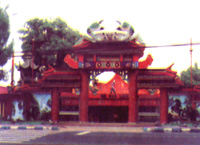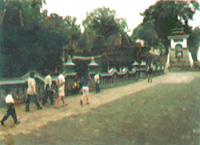|
|
This
temple is located in Tuban Regency, the city lying in the north
coast of East Java.
It is also easy to reach by public transport such as bus or car since its strategic position close to the Surabaya and Jakarta main road, or take only a short walk about two hundred metres from the Tuban bus terminal.
The worship place of Kwan Sing Bio temple is predicted to have
been built in the seventh century and it was also believed to
have high supernatural quality, therefore lots of Hindu pilgrims
visite there daily, especially on holidays of Chinese calendar
Imlek and the birthday of Kwan Ping Thai Tjoe, Kwan Sing Tee Koen,
and Tjoe Jong Tiang Koen.
The temple faces northward to the seashore.
The Indonesian Chinese communities believe that God will easily
grant every prayer spelt in this direction. One of its uniqueness
is the giant crab standing on the gateway, and such a kind of
this is away from the custom since most of the temples have symbol
of dragon and peacock.

The
story of building up the temple is quite unique, as there was
a mystical thing happened before starting work. Once, some Buddhists
wanted to move the statue of Kwan Kong located at Tambakrejo village
to somewhere in Surabaya by sea. The ship, however, suddenly span
and therefore she could not continue her trip. They prayed together
and got an inspiration that the statue did not want to move to
another place. Finally, they went back to Tambakrejo village and
built a temple there. The statue is believed to have existed there
during the 13 th century, the time when the Mongolian troops attacked
Indonesia.
Visit : Kwan Sing Bio Website

Mt.
Kawi is another Java's sacred mountain, lying in the south of Malang. It attracts a steady stream of visitors from all over
Indonesia and even further afield. The focus of attention is the'
tombs of two revered histbrical figures, Kanjeng Panembahan Djoego,
a descendant from the court of Madura and grandson of the famous
rebel leader Prince Diponegoro, and Raden Mas Iman Soedjono, descending
from the royal family of Yogyakarta.
In front of the sacred tomb, there is a dwarf tree called "Dewan
Daru" surrounded by a fence.
Pilgrims to the tomb can often be seen sitting beneath the tree,
in the hope of picking up a leaf freshly blown off by the wind,
which is believed to bring good fortune.
Mt. Kawi is especially popular among the Indonesian Chinese communities
and the villagers, which have grown up around the pilgrimage site,
displays a unique blend of Javanese and Chinese cultures.

There is a mosque and there are Chinese fortunetellers and small
shops selling Chinese candles, incense and various handicrafts
along the street toward tne tombs. Auspicious times for visiting
there are, according to the Javanese calendar, Jum'at Legi (Friday)
and Senin Pahing (Monday).
Visit : Mount Kawi Website
|
|

